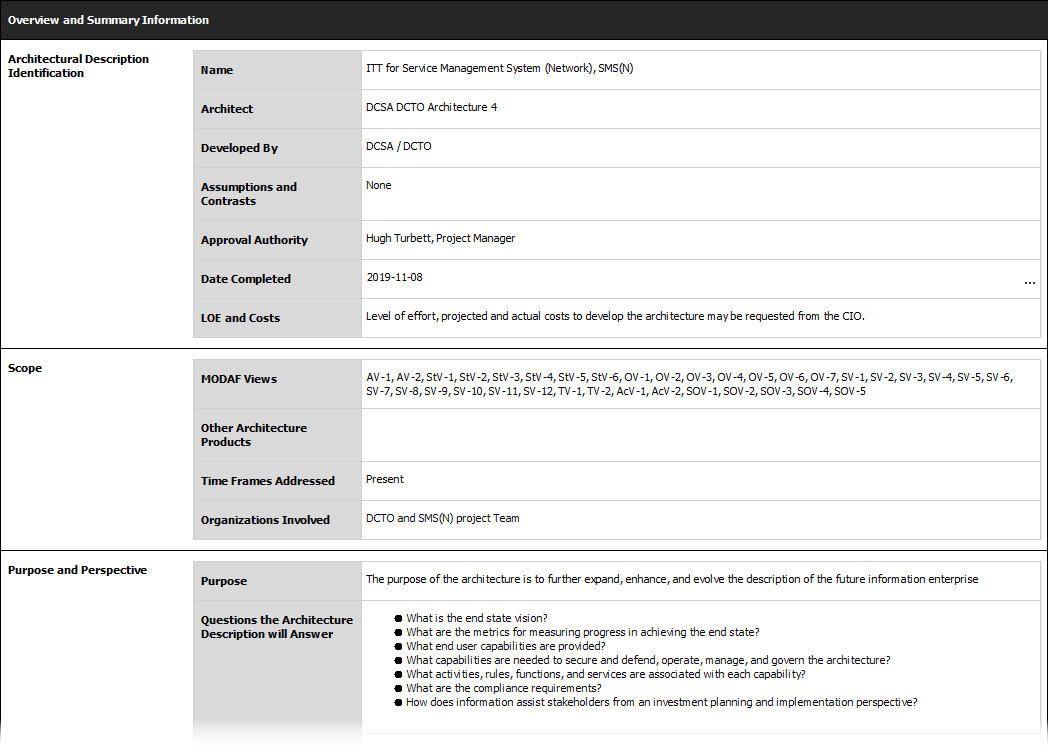The AV-1 provides executive-level summary information about the architecture in a consistent form that allows quick reference and comparison between architectural descriptions. The AV-1 includes assumptions and constraints that may affect high-level decisions relating to an architecture-based work programme. The AV-1 also puts the architecture in context of the Enterprise it describes and the period of time the architecture covers. This context is intended to enable registration and discovery of architectures.
Usage
The intended usage of the AV-1 includes:
- Scoping the project.
- Providing context to the project.
- Defining an architecture-based task.
- Summarizing the findings from an architecture-based task.
- Assisting search within an architecture repository.
Product Description
AV-1 has three products:
- Overview and Summary Information (Text)
- Enterprise Phases (Diagram)
- Enterprise Phases (Table)
Overview and Summary Information
A structured text product that documents the following information about the architecture:
- Architectural Description Identification: the architecture project name, the architect, and the organisation developing the architecture. It also includes assumptions and constraints, identifies the approving authority and the completion date, and records the level of effort required to develop the architecture.
- Scope: the Views and Products that have been developed and the temporal nature of the architecture, such as the time frame covered, whether by specific years or by designations such as current, target, transitional, etc. Scope also identifies the Enterprises and Enterprise Phases that fall within the scope of the architecture.
- Purpose and Perspective: the need for the architecture, what it will demonstrate, the types of analyses that will be applied to it, who is expected to perform the analyses, what decisions are expected to be made on the basis the analysis, who is expected to make those decisions, and what actions are expected to result.
- Context: a description of the setting in which an architecture exists. Context includes such things as mission, doctrine, concepts of operation, threats, environmental conditions, and geographical areas addressed. Context also identifies the rules, criteria, and conventions that are used in the architecture. Any linkages to parallel architecture efforts should be identified.
- Tools and Files Formats Used: the tool suite used to develop the architecture and file names and formats for the Architectural Products if appropriate.
Enterprise Phases (Diagram)
A diagram that shows the decomposition of enterprises and outlines the phases for an enterprise over a period of time.
Enterprise Phases (Table)
A list of phases created in Enterprise Vision (Diagram). The start and end date should be provided for each phase.
Creating an Enterprise Phases (Diagram)
The AV-1 also puts the architecture in context of the Enterprise it describes and the period of time the architecture covers. To create the diagram:
- Click on Enterprise Vision in the Action Artifact area, and then select Create New Diagram.
- Type the diagram name and press Enter.
- A blank diagram is created and you can start constructing the view. You can create enterprises (i.e. WholeLifeEnterprises) can have them decomposed into sub-enterprises and enterprise phases (i.e. EnterprisePhases).
Creating an Overview and Summary Information
AV-1 is a structured text product. To create such a product:
- Click on Overview and Summary Information in the Action Artifact area.
- Fill-in the fields
Overview and Summary Information

Enterprise Phases (diagram)

Enterprise Phases (table)

MODAF in Visual Paradigm
The MODAF is brought to you by Visual Paradigm, a full-featured development platform. Visual Paradigm provides an easy-to-use, model-driven MODAF tool that supports the development of MODAF views and models. You can create integrated MODAF products and generate architectural documents that facilitate organizations to efficiently coordinate enterprise architecture initiatives.